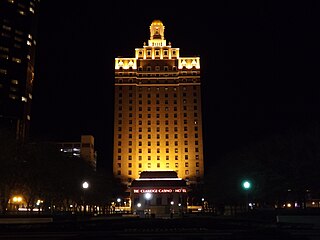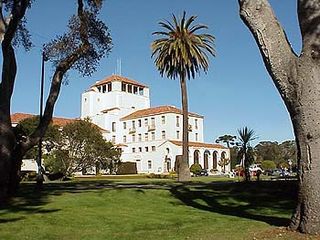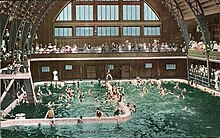
Aptos is an unincorporated town in Santa Cruz County, California, United States. The town is made up of several small villages, which together form Aptos: Aptos Hills-Larkin Valley, Aptos Village, Cabrillo, Seacliff, Rio del Mar, and Seascape. Together, they have a combined population of 24,402.

The Lido, or Venice Lido, is an 11-kilometre-long (7-mile) barrier island in the Venetian Lagoon, Northern Italy; it is home to about 20,400 residents. The Venice Film Festival takes place at the Lido late August/early September.
A seaside resort is a city, town, village, or hotel that serves as a vacation resort and is located on a coast. Sometimes the concept includes an aspect of official accreditation based on the satisfaction of certain requirements, such as in the German Seebad. Where a beach is the primary focus for tourists, it may be called a beach resort.

The Jersey Shore, commonly referred to locally as simply the Shore, is the coastal region of the U.S. state of New Jersey. Geographically, the term encompasses about 141 miles (227 km) of oceanfront bordering the Atlantic Ocean, from Perth Amboy in the north to Cape May Point in the south. The region includes Middlesex, Monmouth, Ocean, Atlantic, and Cape May counties, which are in the central and southern parts of the state. Located in the center of the Northeast Megalopolis, the northern half of the shore region is part of the New York metropolitan area, while the southern half of the shore region is part of the Philadelphia metropolitan area, also known as the Delaware Valley. The Jersey Shore hosts the highest concentration of oceanside boardwalks in the United States.

Mission Beach is a community built on a sandbar between the Pacific Ocean and Mission Bay. It is part of the city of San Diego, California.
The Santa Cruz Beach Boardwalk is an oceanfront amusement park in Santa Cruz, California. Founded in 1907, it is California's oldest surviving amusement park and one of the few seaside parks on the West Coast of the United States.

Fred Wilder Swanton (1862–1940) was an American entrepreneur and real estate developer who served as mayor of Santa Cruz, California from 1927 until 1933. He promoted the expansion of Santa Cruz as a beach resort city. The seaside resort he established in 1904 remains today as the Santa Cruz Beach Boardwalk.

Mediterranean Revival is an architectural style introduced in the United States, Canada, and certain other countries in the 19th century. It incorporated references from Spanish Renaissance, Spanish Colonial, Italian Renaissance, French Colonial, Beaux-Arts, Moorish architecture, and Venetian Gothic architecture.

The Santa Cruz Wharf is a wharf in Santa Cruz, California, United States, known for fishing, boat tours, viewing sea lions, dining, nightlife and gift shops. The current wharf was built in 1914, the last of six built on the site, and is operated by the City of Santa Cruz Parks and Recreation Office. The wharf is situated between Main Beach and Cowell's Beach, on the westside of the city of Santa Cruz. With a length of 2,745 feet (836.68 m), it is the longest pier on the West Coast of the United States.
Swanton is a small community in an unincorporated area of Santa Cruz County on the Pacific coast, situated about 5 miles (8.0 km) north of the town of Davenport, to the east of State Route 1 on Swanton Road. The US Geological Survey designates Swanton as a populated place located at latitude and longitude 37.06417°N 122.22639°W with an elevation of 135 ft (41 m). The ZIP Code is 95017 and the community is inside area code 831.

Hammels is an area within Rockaway Beach on the Rockaway Peninsula in the New York City borough of Queens. It is located west of Arverne and east of Seaside, and is centered on Beach 84th Street. Its main thoroughfare is Beach Channel Drive. The New York City Subway's A train travels through the neighborhood on the IND Rockaway Line. The Hammel Houses, a public housing project built in 1955, is located in the neighborhood.

The Traymore Hotel was a resort in Atlantic City, New Jersey. Begun as a small boarding house in 1879, the hotel expanded and became one of the city's premier resorts. As Atlantic City began to decline in its popularity as a resort town, during the 1950s and 1960s, the Traymore diminished in popularity. By the early 1970s the hotel was abandoned and severely run down. It was imploded and demolished between April and May 1972, a full four years before the New Jersey Legislature passed the referendum that legalized gambling in Atlantic City.

The Claridge is a historic hotel in Atlantic City, New Jersey, that opened in 1930. Beginning in 1981, Claridge's operated for many years as a casino, known first as "Del Webb's Claridge Hotel and Casino", then as "Claridge Hotel and Casino". The hotel was acquired by Bally's on December 30, 2002, as a hotel tower of Bally's Atlantic City. In February 2014, the property was acquired by TJM Properties of Clearwater, Florida, which returned the property to a stand-alone hotel without casino gambling.

Santa Cruz Looff Carousel and Roller Coaster On The Beach Boardwalk is a National Historic Landmark composed of two parts, a Looff carousel and the Giant Dipper wooden roller coaster, at the Santa Cruz Beach Boardwalk in Santa Cruz, California, United States. They are among the oldest surviving beachfront amusement park attractions on the west coast of the United States. They were listed as a pair as a National Historic Landmark in 1987.

The Hotel Del Monte was a large resort hotel in Monterey, California, from its opening in 1880 until 1942. It was one of the finest luxury hotels in North America. During World War II, it closed and the building was leased to the United States Navy. It first was used by the Navy as a school where enlisted men spent the second, third, and fourth months of an 11-month course being trained as electronic technicians. Later the Hotel Del Monte became the Naval Postgraduate School. Today, the building is named Herrmann Hall. It contains school administrative offices and the Navy Gateway Inns and Suites, a hotel.

The Suntan Special was a summer excursion train service operated by the Southern Pacific Railroad between San Francisco and Santa Cruz, California, from 1927 to 1959.





























